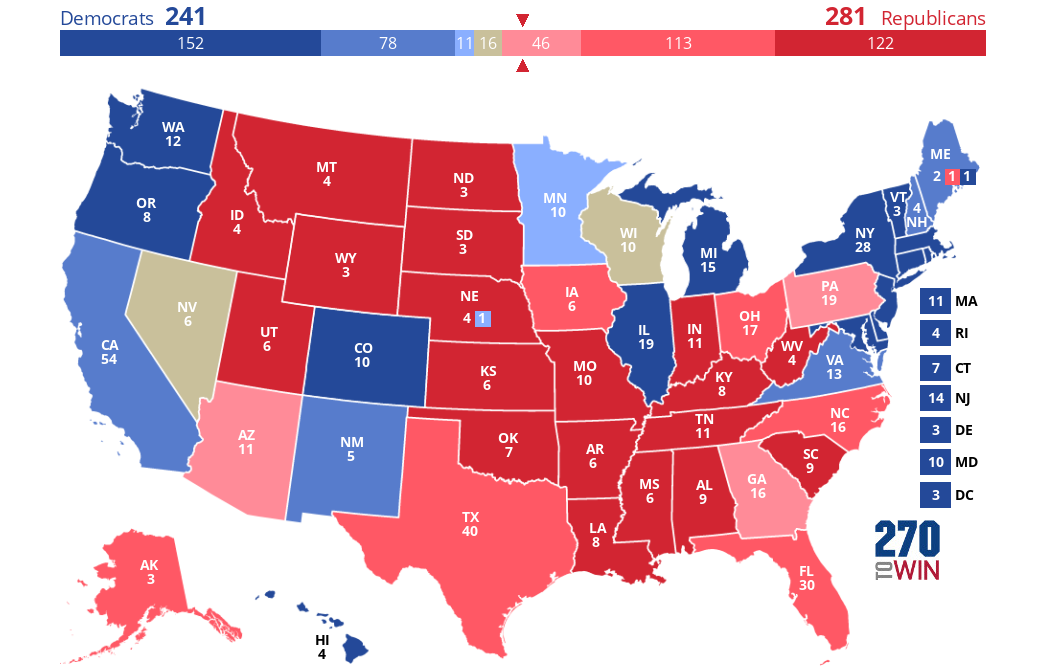Or, as I'd put it perhaps less optimistically: Seven battleground states all end in virtual dead heats in Emerson polling. Add to that this is only one pollster in a sea of survey companies, albeit one with a little more heft. Healthy skepticism should be the rule, but we have other data that may justify sunnier takes on these new results.
Let's take a look at the final poll results in each of the states. First off, Kamala Harris only leads in one state, and ties in two others, while Donald Trump has leads in four:
- AZ: Trump 50%, Harris 48%
- GA: Trump 50%, Harris 49%
- MI: Harris 50%, Trump 48%
- NC: Trump 49%, Harris 48%
- NV: Harris 48%, Trump 48%
- PA: Trump 49%, Harris 48%
- WI: Trump 49%, Harris 49%
Taking these at face value, the Electoral College map would produce a win for Trump, even without the three states in which Harris ties or has a lead:
Should we take these at face value? As far as polling data goes, they compare pretty well to the RCP aggregates as of yesterday afternoon, before these results got added. RCP has Nevada in Trump's column by a full point, but otherwise, Emerson matches up almost exactly to RCP's aggregate averages. They match up so well that one has to wonder whether Nate Silver's warning about "herding" applies here.
What about the "shy-voter polling syndrome"? That would be even more reason for optimism. If pollsters still have trouble getting Trump-friendly demos to answer surveys at the same rate as in 2020, we may be heading into a broader Trump victory. Consider that the underestimation of Trump support in both 2020 and in 2016 came in Wisconsin (six full points), Pennsylvania (3.1 points in 2020), and Michigan (2.3 points in 2020), and that map may be overly optimistic for Harris and her supporters.
Even if we discount the shy-voter polling syndrome for 2024, we have other evidence of GOP-leaning enthusiasm in this election from early voting. Republicans are ahead in Nevada, Georgia, and Arizona. They trail significantly in Pennsylvania, but Democrats are falling far short of their 2020 early-vote participation totals while the GOP has improved theirs; the gap is narrower by several hundred thousand ballots than four years ago (and eight years ago too, IIRC).
In North Carolina, where Hurricane Helene hit the Republican-heavy western part of the state particularly hard, Republicans led early voting for the first time ever:
North Carolina voters have cast a record over 4 million ballots during early voting. While the number of ballots cast is higher than years past, so is the turnout by Republicans during early voting. ...
Lyon is also among the more than 1.3 million Republicans who’ve cast an early vote, the largest voting group in the state so far. It’s a change from previous years when Democrats have shown out to early voting in larger numbers. ...
Democrats currently sit at about 50,000 fewer ballots, but they could be helped with more Hispanic voters, who could play a crucial part this election. Nearly 100,000 Hispanic voters have cast their ballot in this election. Among them is Freddy Roman, who said he has been hurt by some political rhetoric.
Unaffiliated voters beat both Republicans and Democrats in NC early voting. Trump leads the North Carolina RCP aggregate average by 1.5 points and Harris had led only two polls over the last two weeks. Most of the pollsters covering the battleground states make hash out of their crosstabs, but Atlas Intel (Trump +2) shows indies splitting for Trump 49.4/44.7. That plus the boosted GOP turnout in early voting suggests that Trump's support may not be coming fully through in this poll and others in that state, too.
Finally, the most telling data may have come several weeks ago. Gallup reported that the GOP had gained a significant shift in party identification, earning Republicans their first pre-election lead for the first time in over 30 years of surveying party-ID:
More U.S. adults identify as Republican or say they lean toward the Republican Party (48%) than identify as or lean Democratic (45%). Those figures are based on an average of Gallup polls taken during the third quarter (July to September) to minimize poll-to-poll variation in party identification estimates and to provide more reliable comparisons across presidential years given the different timings of the two major party conventions in July, August or September.
Party affiliation and voting are strongly predictive of individuals’ vote choices, with the vast majority of identifiers and leaners voting for the candidate of their preferred party. At the aggregate level, there are typically more Democrats and Democratic leaners than Republicans and Republican leaners in the U.S. adult population. Democrats have won presidential elections in years in which they had larger-than-normal advantages in party affiliation, including 1992, 1996, 2008, 2012 and 2020.
In years when the advantage was narrower -- 2004 and 2016, for example -- Republicans won in the electoral college if not also the popular vote.
This is the most impressive indicator in the field. Party-ID shifts in a cycle on this scale -- from D+5 in a narrow 2020 election to R+3 now -- indicate voter intent on a broad scale. That analysis gets reflected in the major early-voting gains for the GOP this cycle, as well as polls that may be still afflicted by shy-voter polling syndrome.
But there's no better way to win elections than to actually vote -- and to take friends with you to do the same. Cautious optimism is no replacement for victory, and this election is still very close in the data we have.









Join the conversation as a VIP Member